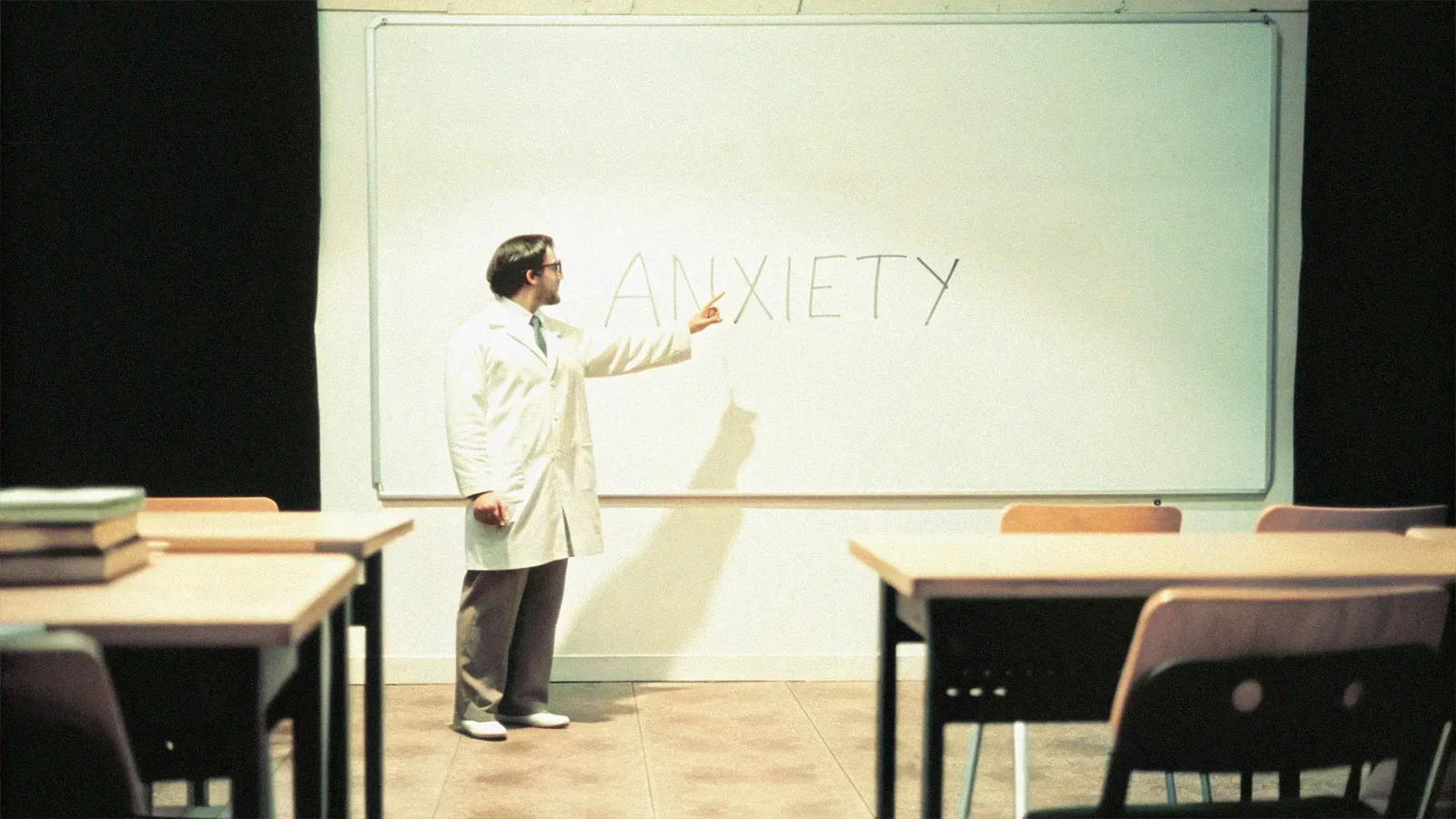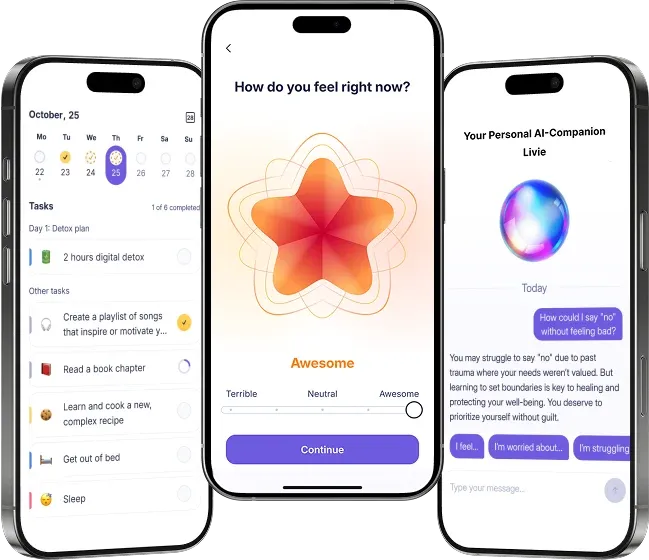The Science of Anxiety: How It Affects Your Brain

Before we get into how anxiety affects the brain, let's take a beat to understand what anxiety is. Anxiety in general is a state of inner turmoil, characterized by feelings of dread over anticipated events. It can arise without an immediate stressor due to biological and psychological factors. Anxiety disorders are a group of mental disorders wherein the person suffering from it has significant and uncontrollable feelings of anxiety and fear to the point where their ability to function in social, occupational, and personal scenarios are negatively impacted.
Anxiety involves a state of heightened vigilance as a response to a perceived danger. This triggers a cascade of physiological and psychological changes in your brain as well as the rest of your body. The way you process emotions, areas critical for memory and learning, even higher level cognitive functions like decision-making and emotion regulation is impacted when you suffer from anxiety. In this article, we're going to delve into the intricacies of anxiety disorders and learn in depth how anxiety affects the brain, so that you can gain a better understanding of yourself.
The Role of the Amygdala
The amygdala plays a crucial role in fear processing but is also involved in other emotional responses. It initiates a cascade of neural and hormonal responses that activate the body's stress system. It rapidly assesses sensory information, and if a threat is perceived, the amygdala triggers a cascade of reactions that prepares your body to 'fight, flee, or freeze'. Through millennia of evolution, this has helped humans survive even the most dangerous ordeals. Let's explore how the amygdala works, and anxiety affects it.
How does the Amygdala Trigger the Fear Response?
First, the amygdala has to receive sensory information. This includes sight, sound, and smell. There are two pathways it can take- A fast and direct path, or a slower but more detailed path through the cerebral cortex. Let's take a look at the difference between these two paths:
- Direct route: This path carries crude information. You sense something, and the information is transported to your thalamus, and then directly to your amygdala. This path is known as the 'Subcortical Route'. It's fast and unconscious, meaning a response is triggered in mere milliseconds before you can even process what's happening.
- Indirect route: This path is slower, but it provides more detailed information about the stimulus, and allows you to make a conscious assessment of the situation. Known as the 'Cortical Route', this path takes the information to your thalamus, then to your cortex, and finally to your amygdala. Research indicates that the fast response can occur in as little as 12 milliseconds, while the slower response may take 250–300 milliseconds.
When the amygdala perceives a threat, it triggers the fear response which activates the areas involved in the preparation of motor functions involved in the fight or flight response. The fear response from the amygdala triggers a neural response in the hypothalamus, followed by the activation of the pituitary gland and the secretion of the adrenocorticotropic hormone. This causes the adrenal gland to activate and release epinephrine, and the chemical messengers released create cortisol. This in turn results in increased blood pressure, blood sugar, and suppresses the immune system. All this is done in an effort to boost energy by having epinephrine bind to liver cells, causing the production of glucose. The circulating cortisol also turns fatty acids into available energy, which prepares the muscles all over the body for a response. Because of the amygdala's fear response, the following physiological changes take place:
- Increased blood flow to muscles by diverting blood flow from other parts of the body
- Increased blood pressure and heart rate enhance cardiac output to supply the body with more energy
- Liver secretes increased amounts of glucose and fats into the blood to meet energy demands
- Increased respiratory rate to supply oxygen necessary to help burn the extra glucose
- Blood clotting function speeds up in order to reduce bleeding and prevent excessive blood loss in case of an injury
- Increased muscle tension to provide the body with extra speed and strength, which can result in trembling or shaking
- Pupils dilate to let in more light, allowing better vision
Amygdala Overactivity in Anxiety Disorders
People who suffer from different anxiety disorders tend to have an overactive amygdala. This is true even when there is no perceived danger or any justifiably stressful situations to be wary of. In conditions such as panic disorder, post traumatic stress disorder (PTSD), and social anxiety disorder, the amygdala shows heightened activity and even has altered connectivity to other brain regions. The overactivity of the amygdala leads to frequent and intense feelings of fear and anxiety, even in scenarios that don't justify it. This contributes to chronic distress which defines anxiety disorders.
For example, social anxiety disorders are characterized by feelings of anxiety or fear in situations like meeting new people, having to make small talk, or anywhere they may be judged or scrutinized. This debilitating anxiety is brought on by the hyperactivity of the amygdala (and the dysfunction in the medial prefrontal cortex is involved, too). In an experiment where subjects with social anxiety disorder were shown pictures of harsh (angry, disgusted, fearful) faces and happy faces, the extent of their amygdala activation positively correlated with the severity of social anxiety symptoms. It shows that in any sort of chronic anxiety disorder, the amygdala's overactivity is the source of the issue.
In the resting state, amygdala activity is highly inhibited, which can avoid being activated by weak external stimuli and produce inappropriate emotional expression and abnormal behavior. In pathological conditions, the inhibitory tone of the amygdala is removed, leading to hyperactivity of the amygdala, which then leads to greater sensitivity to environmental stimuli even after long-term recovery.
Stress Hormones and Their Effects
The physiological changes brought upon by anxiety disorders are mostly driven by the release of stress hormones. While they're vital for responding to immediate threats, the chronic elevation of these hormones has significant effects on both the body and the brain.
The Role of Cortisol and Adrenaline
Cortisol and adrenaline production are stimulated whenever your amygdala perceives a threat. Let's see what these stress hormones do for you:
Cortisol
- Suppresses inflammation
- Regulates blood pressure
- Increases and regulates blood sugar
- Helps control sleep-wake cycle
Adrenaline (Epinephrine)
- Dilates pupils to let more light in to help you see the surroundings better
- Causes vasoconstriction in the skin and digestive organs while dilating blood vessels in the muscles, leading to increased blood flow to muscles and a pale complexion
- Increases heart rate and blood pressure
- Stored glycogen in the liver is converted to glucose to provide more energy
- Breathing is deeper and faster to provide more oxygen for the blood
Adrenaline triggers immediate physiological changes, whereas cortisol is slowly released and has long-lasting effects. Cortisol regulates the body's stress response, and in combination with adrenaline, it enables rapid response to stressors and helps maintain the equilibrium in the body.
Long-Term Effects of Chronic Stress on the Brain
While stress hormones are essential and unavoidable, chronic stress has been shown to negatively impact the brain in the long-term. Several brain areas, such as the hippocampus and prefrontal cortex, are negatively impacted in particular. The hippocampus is critical for memory formation and spatial navigation, and chronic stress can impair its function. This causes difficulties with memory and learning. The prefrontal cortex is associated with decision making and emotional regulation, and chronic stress can reduce hippocampal volume by decreasing neurogenesis and increasing neuronal atrophy. This further reduces a person's ability to manage stress effectively. Chronic stress even increases the amygdala's reactivity, which then makes the person more anxious and prone to anxiety disorders. This creates a feedback loop, exacerbating anxiety, stress, and its impact on the brain unless preventive measures are taken.
Neural Pathways and Anxiety
Anxiety affects more than just different brain regions. It has significant effects on the connections between these areas, which are known as neural pathways. Suffering from chronic anxiety disorders can end up rewiring these pathways, which will then alter how the brain processes different information and responds to these stimuli. Let's take a look at how exactly an anxious brain can change, and if there's a way to revert to a healthy brain.
How Anxiety Rewires The Brain
Neuroplasticity is the ability of the brain structure to learn and adapt. Every time you learn something new, your brain is rewiring its internal pathways and forming new synaptic connections. The brain has structural and functional plasticity. Structural plasticity is brought upon by experiences that create pathways to solidify learned information, whereas functional plasticity is the construction of pathways around damaged brain areas to work around an injury or weakness. Together, this helps your brain regions adapt to all sorts of scenarios and prepare itself for the future.
However, in the same way that learning new things incites neuroplasticity in a positive manner, chronic anxiety and stress can alter neural pathways in maladaptive ways. The constant activation of certain circuits, such as the ones used in the stress response will end up strengthening some connections while weakening others. In the case of chronic anxiety disorders, the brain can end up with increased amygdala activity, but weakened inhibitory control from the prefrontal cortex, which leads to a stronger fear response. This results in the over-reactive response to everyday stressors typical in anxiety disorders. At the same time, the branches between rational thought and calmness can get weakened, which results in unbalanced, overly emotional responses to events that don't require it. Without treatment and preventive measures, this rewiring process can continue to deteriorate your ability to deal with anxiety and stressful situations, further worsening your mental health.
Plasticity and Potential For Recovery
While the idea that anxiety can physically affect your brain may seem unsettling, the brain's plasticity allows for adaptation and improvement. After all, the mechanism of neuroplasticity implies that it can compensate or adapt. One of the most effective interventions is Cognitive Behavioral Therapy (CBT). This process allows you to assess and reframe negative thought patterns and processes. Even mindfulness and meditation have been proven to be associated with neuroplasticity, reducing age-related brain degeneration and improving cognitive function.
Through persistent effort and a combination of CBT, mindfulness, and meditation, you will be able to reestablish control over overactive responses by enhancing emotional regulation and self-awareness through neuroplasticity. Over time, the circuits associated with calm and logical responses will be strengthened, which will then help you reduce the anxiety felt by the emotional brain and improve your mental health.
Anxiety and Cognitive Functions
Aside from the physical symptoms of anxiety, it also has a major impact on cognitive function. Someone suffering from an anxious brain and chronic anxiety in general has changes in areas such as the hippocampus and prefrontal cortex. This impacts their ability to make decisions, think clearly, and even their memory. Before you can work on fixing these issues, it's important to understand exactly how anxiety affects the brain in these regions.
Impact on Memory and Decision-Making
When the body has a consistently high level of hormones like cortisol, brain regions like the hippocampus are negatively impacted, causing issues with forming new memories and recalling information. This causes short-term and long-term memories to be impacted. On top of this, the prefrontal cortex's functionality is also reduced, which can then cause an individual to be more prone to acting on intrusive thoughts, have difficulty thinking clearly while experiencing intense emotions, and exacerbated anxious responses as a whole. Combined, cognitive function is limited in stressful conditions, making it difficult for the individual to react rationally, as well as impacting their mental health outside of stressful environmental experiences.
Tips to Counteract These Effects
The best way to counteract the various symptoms of anxiety is through a combination of exercise, mindfulness, and therapy:
- Cognitive Behavioral Therapy: CBT helps individuals reframe how they view negative thought patterns, allowing them to improve cognitive flexibility and reduce the impact of anxiety disorders in their daily life.
- Physical exercise: Regular exercise promotes neurogenesis, which can help improve memory function.
- Mindfulness and meditation: This can enhance prefrontal cortex activity, which will allow individuals to have better emotional processing skills and decision-making capabilities.
Current Research in Anxiety Neuroscience
Over the past two decades, research in anxiety neuroscience has rapidly advanced. We've gained an understanding of not just the mechanisms of anxiety disorders, but also how they can be addressed through targeted and effective treatment plans. We've learned that anxiety primarily affects the amygdala and prefrontal cortex; and thanks to this knowledge, as well as other scientific work and research, the study of 'Neurofeedback' appeared. This is a form of neurotherapy which uses electrical potentials to reinforce desired brain states through operant conditioning. It helps individuals learn to regulate brain function associated with anxiety, with quite a bit of success.
Transcranial Magnetic Stimulation is another non-invasive therapy that has been effective at treating anxiety disorders, depression, Post Traumatic Stress Disorder, and even Obsessive Compulsive Disorder. It works by sending a small electric current to the affected parts of the brain, namely the prefrontal cortex. This brain's ability to reorganize itself structurally and functionally is known as neuroplasticity.
Even our ability to study anxiety disorders through brain imaging technologies has made leaps and bounds. Functional Magnetic Resonance Imaging, Electroencephalography, and Magnetoencephalography are non-invasive ways to identify neural signatures associated with anxiety, and it allows medical practitioners to observe real-time changes in brain activity during a state of anxiety. This in turn allows the practitioners to treat the underlying causes with more accuracy.
Conclusion
Fear and anxiety are an unavoidable part of life. Be it a predisposition to anxiety disorders due to family history, traumatic events you've endured like natural disasters, or even a specific phobia that you have to deal with, most people suffer from something in a similar vein. You're not alone in this, and it's important to understand that you can work to make sure anxiety disorders don't control your life. Even if you already have an anxious brain, there is always a possibility to heal. The first step was to learn how anxiety affects the brain, and now you have deeper insight about the kinds of treatments that can help reduce the symptoms and emotions brought on by anxiety. With enough persistent treatment, you won't have to worry about your fight or flight response kicking in at regular social situations, and even anxiety disorders will become more manageable.
Bibliography
Chand, Suma P., and Raman Marwaha. “Anxiety.” National Library of Medicine, StatPearls Publishing, 24 Apr. 2023, www.ncbi.nlm.nih.gov/books/NBK470361/.
Ressler, Kerry J. “Amygdala Activity, Fear, and Anxiety: Modulation by Stress.” Biological Psychiatry, vol. 67, no. 12, 15 June 2010, pp. 1117–1119, www.ncbi.nlm.nih.gov/pmc/articles/PMC2882379/, https://doi.org/10.1016/j.biopsych.2010.04.027.
“Emotions and Emotional Disorders.” OpenLearn, www.open.edu/openlearn/health-sports-psychology/health/emotions-and-emotional-disorders/content-section-2.4.
Margioris, Andrew; Tsatsanis, Christos (April 2011). "ACTH Action on the Adrenal". Endotext.org.
Padgett, David; Glaser, R (August 2003). "How stress influences the immune response". Trends in Immunology. 24 (8): 444–448. https://doi.org/10.1016/S1471-4906(03)00173-X.
Stress Management for Health Course. "The Fight Flight Response".
Olpin, Michael. "The Science of Stress". Weber State University.
Myers, David G.; DeWall, C. Nathan (2021). Psychology (13 ed.). MacMillan Publishing. p. 422.
Phan, K. Luan, et al. “Association between Amygdala Hyperactivity to Harsh Faces and Severity of Social Anxiety in Generalized Social Phobia.” Biological Psychiatry, vol. 59, no. 5, Mar. 2006, pp. 424–429, https://doi.org/10.1016/j.biopsych.2005.08.012.
Hu, Ping, et al. “New Insights into the Pivotal Role of the Amygdala in Inflammation-Related Depression and Anxiety Disorder.” International Journal of Molecular Sciences, vol. 23, no. 19, 1 Oct. 2022, p. 11076, https://doi.org/10.3390/ijms231911076.
Liu Z.P., et al. “Chronic stress impairs GABAergic control of amygdala through suppressing the tonic GABAA receptor currents.” Mol. Brain. 2014;7:32. https://doi.org/10.1186/1756-6606-7-32.
LeWine, Howard E. “Understanding the Stress Response.” Harvard Health, 3 Apr. 2024, www.health.harvard.edu/staying-healthy/understanding-the-stress-response.
McEwen, Bruce S. “Neurobiological and Systemic Effects of Chronic Stress.” Chronic Stress, vol. 1, no. 1, 10 Apr. 2017, p. 247054701769232, https://doi.org/10.1177/2470547017692328.
L, Mah, et al. “Can Anxiety Damage the Brain?” Current Opinion in Psychiatry, 1 Jan. 2016, pubmed.ncbi.nlm.nih.gov/26651008/.
Rădulescu, Ioana, et al. “Neuroplasticity and Depression: Rewiring the Brain’s Networks through Pharmacological Therapy (Review).” Experimental and Therapeutic Medicine, vol. 22, no. 4, 5 Aug. 2021, https://doi.org/10.3892/etm.2021.10565.
Bremner, J. Douglas. “Traumatic Stress: Effects on the Brain.” Dialogues in Clinical Neuroscience, vol. 8, no. 4, Dec. 2006, pp. 445–461, https://doi.org/10.31887/dcns.2006.8.4/jbremner.
Tworek, Grace. “What Is Neuroplasticity? How It Works.” Cleveland Clinic, 12 Dec. 2023, health.clevelandclinic.org/neuroplasticity.
Månsson, K N T, et al. “Neuroplasticity in Response to Cognitive Behavior Therapy for Social Anxiety Disorder.” Translational Psychiatry, vol. 6, no. 2, Feb. 2016, https://doi.org/10.1038/tp.2015.218.
Lardone, Anna, et al. “Mindfulness Meditation Is Related to Long-Lasting Changes in Hippocampal Functional Topology during Resting State: A Magnetoencephalography Study.” Neural Plasticity, vol. 2018, 18 Dec. 2018, https://doi.org/10.1155/2018/5340717.
Liu, Patrick Z., and Robin Nusslock. “Exercise-Mediated Neurogenesis in the Hippocampus via BDNF.” Frontiers in Neuroscience, vol. 12, no. 52, 7 Feb. 2018, https://doi.org/10.3389/fnins.2018.00052.
“Transcranial Magnetic Stimulation (TMS) | Anxiety and Depression Association of America, ADAA.” adaa.org/finding-help/transcranial-magnetic-stimulation.

